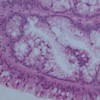Intraductal Papillary-Mucinous Neoplasm of the Pancreas Penetrating to the Stomach and the Common Bile Duct
Abstract
Context Intraductal papillary mucinous neoplasm (IPMN) of the pancreas occasionally penetrates to others organs. We present a case of IPMN penetrating to the stomach and the common bile duct. Case report A 75-year-old man was admitted to the hospital because of epigastric pain. Computed tomography (CT) showed a papillary tumor protruding into the markedly dilated main pancreatic duct and splenic vein obstruction. The tumor was diagnosed as IPMN arising in the main duct, but he rejected surgery and he was followed without treatment. One year later, gastroduodenoscopy revealed gastropancreatic fistula and we were able to pass an endoscope through the fistula and directly examine the lumen of the main pancreatic duct and the papillary tumor adjacent to the fistula. Absence of malignant cells on histopathology suggested mechanical penetration rather than invasive penetration. CT showed splenic vein reperfusion due to decreased inner pressure of the main pancreatic duct. Two and a half years later, CT revealed biliopancreatic fistula formation. Endoscope biliary drainage was performed but failed. Despite jaundice, he is still ambulatory and seen in the clinic three years after the first admission. Conclusions We have experienced a case of IPMN penetrating to the stomach and the common bile duct that has taken a slow course. It represents the importance of distinguishing mechanical penetration from invasive penetration as well as mechanical splenic vein obstruction from splenic vein invasion.Downloads
References
Ohashi K, Murakami Y, Maruyama M, Takekoshi T, Ohta H, Ohashi I, et al. Four cases of mucus-secreting pancreatic cancer (in Japanese). Prog Digest Endosc. 1982;20:348-51.
Matsubayashi H, Kokuno S, Itoi T, Mizumura Y, Niki S, Takeda K, et al. A case of intraductal papillary adenocarcinoma of the pancreas with pancreaticoduodenal fistula. Prog Digest Endosc. 1998;52:180-1.
Fujisawa T, Osuga T, Mita M, Sakamoto N, Sakaguchi K, Onishi Y, et al. A case of intraductal papillary adenocarcinoma of the pancreas accompanied by biliopancreatic fistula. Jpn J Cancer Clin. 2001;47:144-50.
Koizumi M, Sata N, Yoshizawa K, Tsukahara M, Kurihara K, Yasuda Y, et al. Post ERCP pancreatogastric fistula associated with an intraductal papillary mucinous neoplasm of the pancrease: a case report and literature review. World J Surg Oncol. 2005;3:70-4. [PMID 16232325]
Patel A, Lambiase L, Decarli A, Fazel A. Management of the mucin filled bile duct. A complication of intraductal papillary mucinous tumor of the pancreas. JOP. 2005;6:255-9. [PMID 15883476]
Seynaeve L, Van Steenbergen W. Treatment, by insertion of multiple uncovered metallic stents of intraductal papillary mucinous neoplasm of the pancreas with biliary obstruction by mucus impaction. Pancreatology. 2007;7:540-3. [PMID 17901716]
Kim JY, Kang DH, Kim GH, Kim TO, Heo J, Song G, et al. Malignant intraductal papillary mucinous neoplasm of the pancreas with multiple pancreatogastric fistulas: a report of 2 cases with different features. Gastrointest Endosc. 2007;66:854-7. [PMID 17719044]
Jung IS, Shim CS, Cheon YK, Bhandari S, Cha SW, Moon JH, et al. Invasive intraductal papillary mucinous tumor of the pancreas with simultaneous invasion of the stomach and duodenum. Endoscopy. 2004;36:186-9. [PMID 14765321]
Kobayashi G, Fujita N, Noda Y, Ito K, Horaguchi J, Obana T, et al. Intraductal papillary mucinous neoplasms of the pancreas showing fistula formation into other organs. J Gastroenterol. 2010;45:1080-9. [PMID 20549253]
Baek Y, Midorikawa T, Nagasaki H, Kikuchi H, Kitamura N, Takeuchi S, et al. A case report of pancreatic mucinous cystadenocarcinoma with penetration to the stomach. Jpn J Gastroenterol. 1999;96:685-90. [PMID 10396942]
Watanabe N, Hasegawa H, Tsuneya Y, Kumazawa M, Baba M, Kusano I, et al. A case of mucinous cystadenocarcinoma with a fistula between cyst and stomach. Jpn J Gastroenterol. 2003;100:349-53. [PMID 12696179]
Kurihara K, Nagai H, Kasahara K, Kanazawa K, Kanai N. Biliopancreatic fistula associated with intraductal papillary mucinous pancreatic cancer: institutional experience and review of the literature. Hepatogastroenterology. 2000;47:1164-7. [PMID 11020905]
Yamao K, Ohashi K, Nakamura T, Suzuki T, Sawaki A, Hara K, et al. Efficacy of peroral pancreatoscopy in the diagnosis of pancreatic diseases. Gastrointest Endosc. 2003;57:205-9. [PMID 12556785]
Tanaka M, Charis S, Adsay V, Fernandez-del Castillo C, Falconi M, Shimizu M, et al. International consensus guidelines for management of intraductal papillary mucinous neoplasms and mucinous cystic neoplasms of the pancreas. Pancreatology. 2006;6:17-32. [PMID 16327281]
Crippa S, Tamburrino D, Partelli S, Salvia R, Germenia S, et al. Total pancreatectomy: indications, different timing, and perioperative and long-term outcomes. Surgery. 2011;149:79-86. [PMID 20494386]
Tanaka M. Intraductal papillary mucinous neoplasm of the pancreas: diagnosis and treatment. Pancreas. 2004;28:282-288. [PMID 15084972]

Copyright (c) 2014 Norihiro Goto, Masahiro Yoshioka, Motohito Hayashi, Toshinao Itani, Jun Mimura, Kimio Hashimoto

This work is licensed under a Creative Commons Attribution 4.0 International License.
As a member of Publisher International Linking Association, PILA, iMedPub Group’s JOP follows the Creative Commons Attribution License and Scholars Open Access publishing policies. Journal of the Pancreas is the Council Contributor Member of Council of Science Editors (CSE) and following the CSE slogan Education, Ethics, and Evidence for Editors.